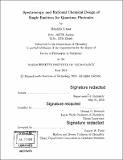| dc.contributor.advisor | Moungi G. Bawendi. | en_US |
| dc.contributor.author | Utzat, Hendrik. | en_US |
| dc.contributor.other | Massachusetts Institute of Technology. Department of Chemistry. | en_US |
| dc.date.accessioned | 2019-10-04T21:35:37Z | |
| dc.date.available | 2019-10-04T21:35:37Z | |
| dc.date.copyright | 2019 | en_US |
| dc.date.issued | 2019 | en_US |
| dc.identifier.uri | https://hdl.handle.net/1721.1/122453 | |
| dc.description | Thesis: Ph. D., Massachusetts Institute of Technology, Department of Chemistry, 2019 | en_US |
| dc.description | Cataloged from PDF version of thesis. | en_US |
| dc.description | Includes bibliographical references (pages 153-175). | en_US |
| dc.description.abstract | Single optical emitters have developed from study objects of fundamental photophysics and local chemical dynamics to technologically relevant building blocks in optical quantum information processing (QIP). This thesis mirrors this development by bridging classical photo-physical studies of single emitters and their rational chemical design towards applications in QIP. In the first part, I survey the energetic heterogeneity, emission linewidths, and singlephoton emission purity of single lead halide perovskite quantum dots (PQDs) in dilute solutions using photon-correlation spectroscopy. I identify PQD's unique minimal inhomogeneous broadening and remarkable tunability of the biexciton Auger recombination rate. Mechanisms for the single emitter linewidths broadening and variable biexciton quantum yield are put forth. In the second part, I assess the optical coherence properties of PQDs as efficient single photon emitters at low temperatures with photon-correlation Fourier spectroscopy. These measurements show that single PQDs exhibit a unique combination of fast radiative lifetimes, long optical coherence times, and suppressed spectral diffusion, which renders their emission highly coherent. I propose that PQDs are the first colloidal quantum dot material with the prospect of indistinguishable single photon and entangled photon pair generation and make strides towards the chemical improvement of PQDs. I extend these studies to single quantum defects in monolayers of two-dimensional hexagonal Boron Nitride (hBN). In the third part, I develop and validate a lineshape model for single CdSe/CdS coreshell quantum dots and show that optical phonons play a pivotal role in determining the room temperature emission linewidth. I undertake efforts to extend solution-based single emitter spectroscopy to the in-flow measurements in microfluidic channels. | en_US |
| dc.description.statementofresponsibility | by Hendrik Utzat. | en_US |
| dc.format.extent | 175 pages | en_US |
| dc.language.iso | eng | en_US |
| dc.publisher | Massachusetts Institute of Technology | en_US |
| dc.rights | MIT theses are protected by copyright. They may be viewed, downloaded, or printed from this source but further reproduction or distribution in any format is prohibited without written permission. | en_US |
| dc.rights.uri | http://dspace.mit.edu/handle/1721.1/7582 | en_US |
| dc.subject | Chemistry. | en_US |
| dc.title | Spectroscopy and rational chemical design of single emitters for quantum photonics | en_US |
| dc.type | Thesis | en_US |
| dc.description.degree | Ph. D. | en_US |
| dc.contributor.department | Massachusetts Institute of Technology. Department of Chemistry | en_US |
| dc.identifier.oclc | 1121043342 | en_US |
| dc.description.collection | Ph.D. Massachusetts Institute of Technology, Department of Chemistry | en_US |
| dspace.imported | 2019-10-04T21:35:33Z | en_US |
| mit.thesis.degree | Doctoral | en_US |
| mit.thesis.department | Chem | en_US |
